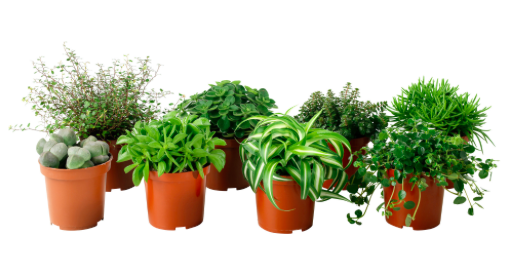Do you know that certain tropical houseplants can remove and process other, more harmful, chemicals from the air inside your home?
Toxic Chemicals in Household Air
Homes and office buildings today are often more polluted than the outdoors. Whether it’s old or new, your home or office could be harboring unhealthy (and invisible) toxins. Modern buildings are tightly sealed and insulated to make them energy efficient, and they’re also full of synthetic materials that emit harmful gases and chemicals into the air. The result is a sealed bubble of unclean air that can lead to what is known as “Sick Building Syndrome.” These chemical compounds are found in emissions from paint, plastics, carpet, cleaning solutions, and numerous building materials. Some of the most common indoor pollutants are:
- Formaldehyde: Commonly used in a number of items including particle board, pressed wood, foam insulation, cleaning products, carpets, upholstery, glues, paint and treated paper or fabric. If your home or office contains particle-board furniture, grocery bags, tissues, paper towels, or anything that has been treated to make it stiffer, wrinkle-resist, fire retardant, or water-repellent, then you’re likely to have formaldehyde in the air.
At the very least, chemicals like these can irritate the eyes and skin, lead to allergic reactions, and cause headaches. At worst, they’ve been linked to more serious problems including asthma, cancer, anemia, organ damage, and birth defects. Given the pervasive presence of these chemical in our homes, it can be difficult to create an environment that is free of them.
In the late 1980s, a two-year research study was conducted by NASA and the Associated Landscape Contractors of America (ALCA) to investigate ways to create healthy, breathable environments in outer space. They found that certain tropical plants, commonly used as houseplants, were quite effective in removing formaldehyde, benzene, and trichloroethane from the air and replacing it with breathable oxygen.
All plants provide some benefit to air quality, but their research showed that tropical plants (grown as houseplants in cooler climates) are particularly effective at processing gases and chemicals. Because they grow in dense rainforests with very little light, they have evolved to be very efficient at photosynthesis, which includes the absorption of gases from the air. In addition, as plants transpire (emit water from the leaves), air is drawn down around the roots, where root microbes quickly adapt and begin “eating” the harmful chemicals that are absorbed.
The result was a list of recommended plants for reducing toxic chemicals in indoor environments. Most are common houseplants that you should be able to find at your local garden center. Two of the recommended plants (Gerbera Daisy and Pot Mum) are ornamental blooming plants that are frequently brought indoors for seasonal decorations.
Plants for Reducing Indoor Air Pollution
- Bamboo Palm (Chamaedorea seifrizii) It transpires a healthy bit of moisture into a room, making it particularly welcome in dry winter months. Care: Although this palm requires bright light to flourish, don’t place it in direct sunlight. Keep the soil moist and feed your plant monthly during summer with an all-purpose liquid fertilizer. Placing the plant where air circulates freely and occasional misting both help deter spider mites. Eliminates: formaldehyde, benzene, carbon monoxide, xylene, chloroform, and more
- Chinese Evergreen (Aglaonema modestum) They are evergreen perennials from tropical forests in Asia. They’re usually grown as foliage plants where they produce numerous leaves, which are attractively patterned or variegated in some varieties. Care: Grow in well-drained potting soil in filtered light and provide high humidity by placing plants above trays of water or by regularly misting with water. Water moderately and allow compost to almost dry out before watering. During the growing season, provide a balanced liquid fertilizer. Repot every two to three years. Eliminates: benzene, carbon monoxide, formaldehyde, trichloroethylene, and more
- Dracaena (Dracaena sp.). Especially Red-Edged Dracaena (Dracaena marginata), Janet Craig (Dracaena deremensis ‘Janet Craig’), Warneckii (Dracaena deremensis ‘Warneckii’), and Corn Plant (Dracaena fragrans ‘massangeana’) Care: There’s a dracaena for every light situation. Keep the soil damp but not soggy. A pot sitting in a water-filled saucer is the kiss of death for this plant. Feed monthly during spring and summer with an all-purpose liquid fertilizer. Eliminates: formaldehyde, xylene, toluene, benzene, trichloroethylene
- English Ivy (Hedera helix) It is an evergreen climbing plant that is well adapted to indoor conditions. They’re easily grown as houseplants in hanging baskets or containers and are an excellent choice for low-light situations. Use green-leaved varieties to provide contrast against lighter surroundings and choose variegated forms to brighten up dark corners. English Ivy is recommended for removing allergens such as mold and animal feces. Care: Green-leaved varieties will grow in bright indirect light and low-light situations. Pale, variegated forms need bright, indirect light to thrive. Water generously during growth and keep compost moist but not waterlogged through the winter months. Apply a balanced liquid fertilizer monthly during growth. Eliminates: benzene, carbon monoxide, formaldehyde, trichloroethylene, and more
- Golden Pothos (Epipiremnum aureum) It is considered one of the most effective indoor purifiers of the plant world. Care: Golden pothos grows in any light situation except direct sunlight. Water it when the soil becomes dry to the touch. Eliminates: formaldehyde, xylene, toluene, benzene, carbon monoxide, and more
- Peace Lily (Spathiphyllum sp.) Care: The peace lily thrives in both low and bright light. Keep the soil slightly moist and feed monthly during spring and summer with an all-purpose liquid fertilizer. Low-light conditions inhibit flower production. Eliminates: formaldehyde, benzene, trichloroethylene, xylene, ammonia, and more
- Philodendron (Philodendron sp), particularly Heartleaf (Philodendron scandens ‘oxycardium’), Selloum (Philodendron selloum), and Elephant Ear Philodendron (Philodendron domesticum)
- Pot Mum (Chrysanthemum morifolium) Commonly called a “mum” is one of the best. Technically it is not a houseplant, and they can survive about six weeks with proper care. Care: Place the chrysanthemum in bright, indirect light. Check the soil’s moisture every other day, and keep it damp. Eliminates: formaldehyde, xylene, benzene, ammonia
- Rubber Plant: Rubber plants are evergreen trees from India. Tropical in appearance, they make handsome container specimens. Leaves are typically broad, deep green and shiny. Tests have shown that rubber plants are especially efficient at removing formaldehyde from the air. Care: Grow in full or bright, filtered light. When in growth, water moderately and apply a high nitrogen fertilizer monthly. Keep the compost moist in winter. Some pruning may be necessary to reduce plant size. Retain leaf shine by wiping with a damp cloth periodically. Eliminates: carbon monoxide, formaldehyde, trichloroethylene and more
For best results, have at least one 15cm plant for every 10 square meter.


